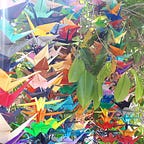Growing the Ecological Self: Wind
--
Continuing the Deep Ecology Practice series, expanding our sense of who we are by connecting with the wild world: today, the wind.
The wind is magic
Folk stories know this. In a forest, the wind feels like unseen beings passing. In the medieval romance Sir Orfeo the hero, a harpist, retreats to the forest to live wild after his wife disappears, stolen by fairies. The tale is a reimagining of the story of Orpheus, but in this story Orfeo never goes to hell. Instead, in the forest he sometime sees a fairy troop passing by, hunting, or marching as if to war, or enjoying the summer weather. They pass without trace and kill nothing in their hunts.
This troop has often entered my mind on a windy day in a woodland, because among the trees you cannot easily see what is nearby. The wind carries rumours, but most of what lives there is hidden from sight.
After ten years in the woods, Orfeo sees his wife among the troop and finds his way to the fairy castle. It is a strange place where people stand frozen in the courtyard like statues, in poses caught between life and death, some missing limbs or drowning or giving birth.
Orfeo’s music convinces the fairy king to return his wife, and the pair reclaim their kingdom and live many happy years together.
The fairy hunt moving among the forest, invisible to most eyes, recalls the widespread stories of the wild hunt, another magical embodiment of the wind. The wild hunt may be ghosts, fairies or demons. It is always dangerous, and can snatch a human away with it upon a storm wind.
But the wind is not always dangerous in folklore. Some fairytales have the hero or heroine visit the winds to ask for guidance on their quest. For example, in the Norwegian tale, East of the Sun, West of the Moon, the heroine is helped in her long search for her husband by each of the winds in turn, East, West, South and North.
Or the wind may sweep you into a story, like in the fanciful Irish tale, The Man Who Had No Story, where the timid hero claims never to have told a story in his life. The wind carries him to a strange wake where he must play the role of fiddler, priest and doctor, before the wind returns him home with a tale to tell.
These traditional stories give us a taste of how people through the ages have understood the wind: wild, unpredictable, carrying tales and knowledge, with a mysterious power to carry us away too, into an adventure.
The wind is free
The wind comes through city streets and over tree tops, always roaming and full of stories. Listening to the wind, or feeling it on your skin is contact with the living world. The wind doesn’t care about borders.
You can’t grasp the wind or make it stay. It is freedom. The wind carries seeds. It keeps the air we breathe fresh and life-giving. It expresses the world’s endless motion.
The wind is a wonderful meditation teacher, because it reminds us the wisdom of letting go. With the wind, we have no choice but to enjoy the endless flow. If you tried to stop it, it would cease to exist.
The wind is alive
The wind is closely associated with the air and the breath, and in turn with life and spirit. In Hebrew the word rooakh, meaning wind, also means spirit, ghost and soul. The breath brings life, and comes from the wind. In the strange, evocative story of Ezekiel in the valley of dry bones, God brings the bones to life, first covering them with skin and flesh, then calling the breath to them from the four winds (Ezekial, 37: 4–10).
Breath is our experience of the flow of life around the world. The wind carries this energy around the world, like a Chinese dragon in flight through creation, endlessly transforming, dynamic, mysterious. Feeling the wind on our faces, it is a good moment to remember that we are part of an astonishing, living world, as magical as any story.
Practice: Listen to the wind
Wherever you are, the wind will speak to you, if you listen. Open a window or step outside. What do you feel and hear? Where has the wind been, and where is it going? Does it have a story for you? Tune in to its speech.
Making a practice of attending to the wind brings to life another dimension. The wind is expressive of the energy and shifts in the place where you are. Noticing the wind will alert you to changes in the weather. It gives a taste of what life is like for the birds, and the other creatures living outside with the sky, unsheltered by walls and roof.
Some people like to attune to the wind by hanging wind chimes from a tree. Others may be disturbed by the noise, so an alternative is to hang something silent that still responds to the wind, such as a found feather tied to a string. Alternatively, listen to the wind in the leaves of the trees, or the branches in winter as they creak and tap.
Is the wind bringing fresh news, or blowing back to you an old dream you had half forgotten? Try whispering your dreams to the wind, and you might find it gives them wings.
